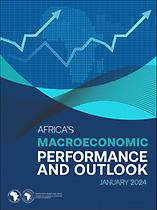
Book
Africa’s Macroeconomic Performance and Outlook - January 2024
Attachments [ 1 ]
More Details
The global economy’s recovery is faltering, and Africa is not immune. Multiple crises including rising living costs, weakening economic growth, increasing effects of climate change, health pandemics, and geopolitical tensions are hindering Africa’s socioeconomic development. The momentum of Africa’s economic recovery has slowed, with average real GDP growth declining to an estimated 3.2 percent in 2023, from 4.1 percent in 2022. This decline is the result of multiple shocks and elevated inflationary pressures, particularly affecting Africa’s leading economies. Despite these challenges, Africa’s economic growth remains resilient, supported by a strong rebound in infrastructure investment spending, a recovery in tourism arrivals after the Covid-19 pan-demic, and the benefits of economic diversification. In 2023, economic growth in 15 countries exceeded 5 percent, and Africa maintained its position as the second fastest growing region after Asia. In a world of rising uncertainty and geopolitical fragmentation, building resilience should remain a strategic priority for Africa. The African Development Bank Group’s latest projections indicate that growth will pick up, rising to 3.8 percent in 2024 and consolidate at 4.2 percent in 2025. This expansion will be broad-based, with a sustained growth momentum expected in 41 countries. Africa’s projected higher growth reflects efforts by countries to diversify their economies and implement domestic policies to reverse the increase in living costs and boost private consumption. However, global risks and pockets of domestic imbalances pose challenges. Geopolitical tensions could disrupt supply chains and reignite commodity price hikes. Inflationary pressures in Africa remain entrenched and have eroded people’s purchasing power and adversely affected livelihoods.
Comments
(Leave your comments here about this item.)